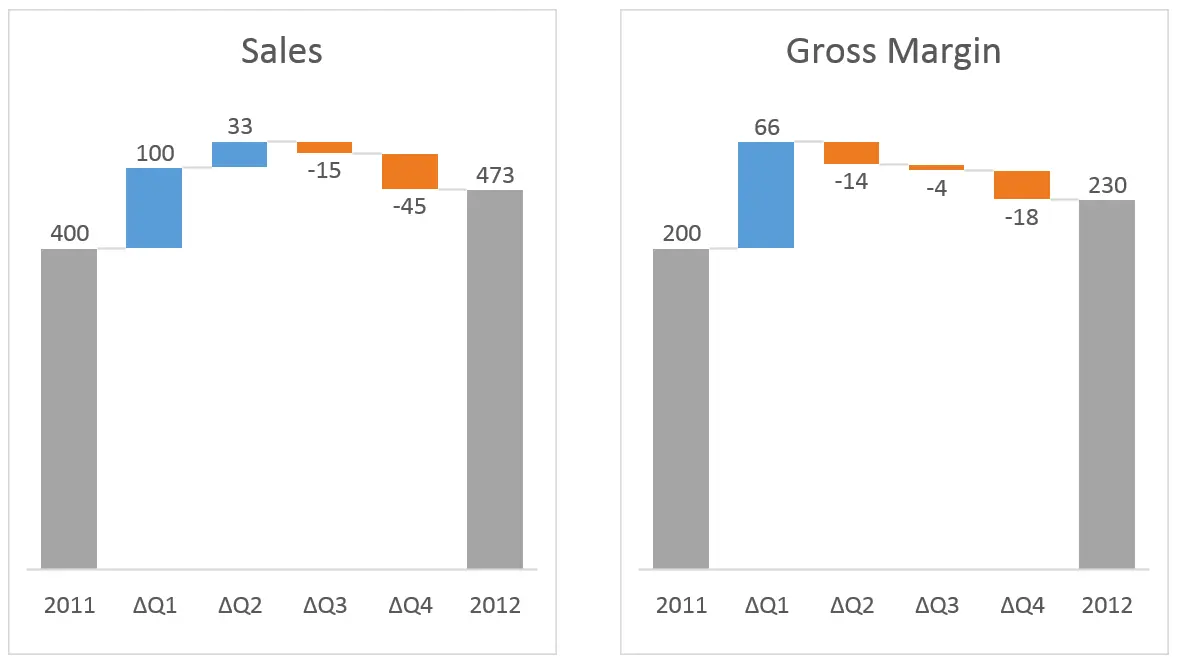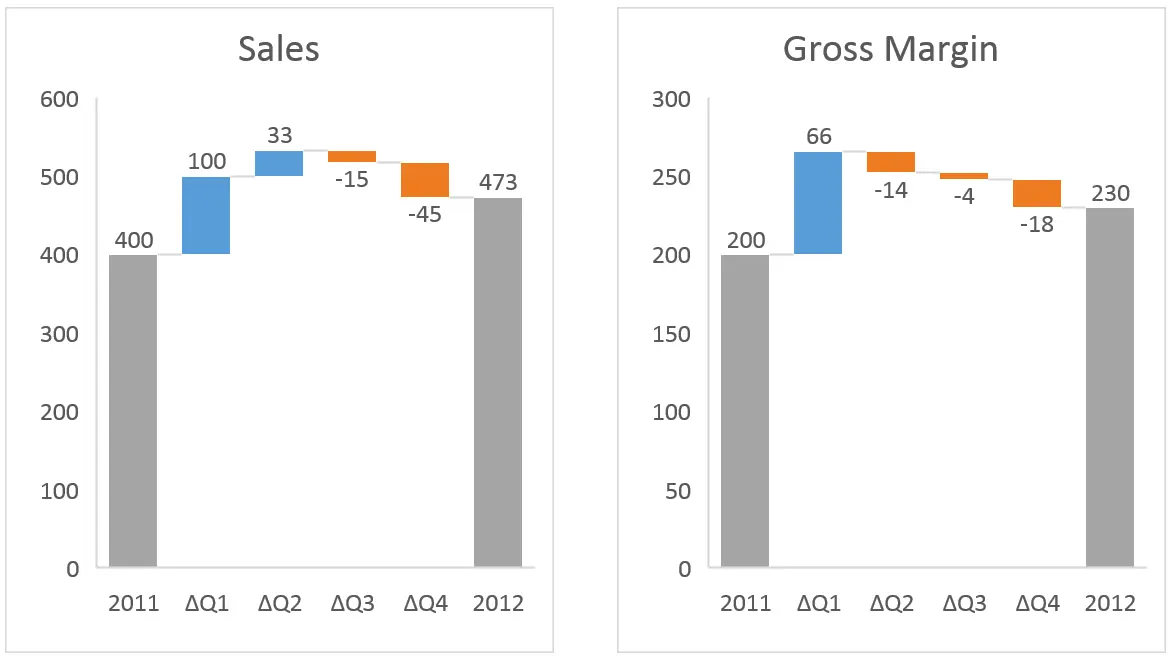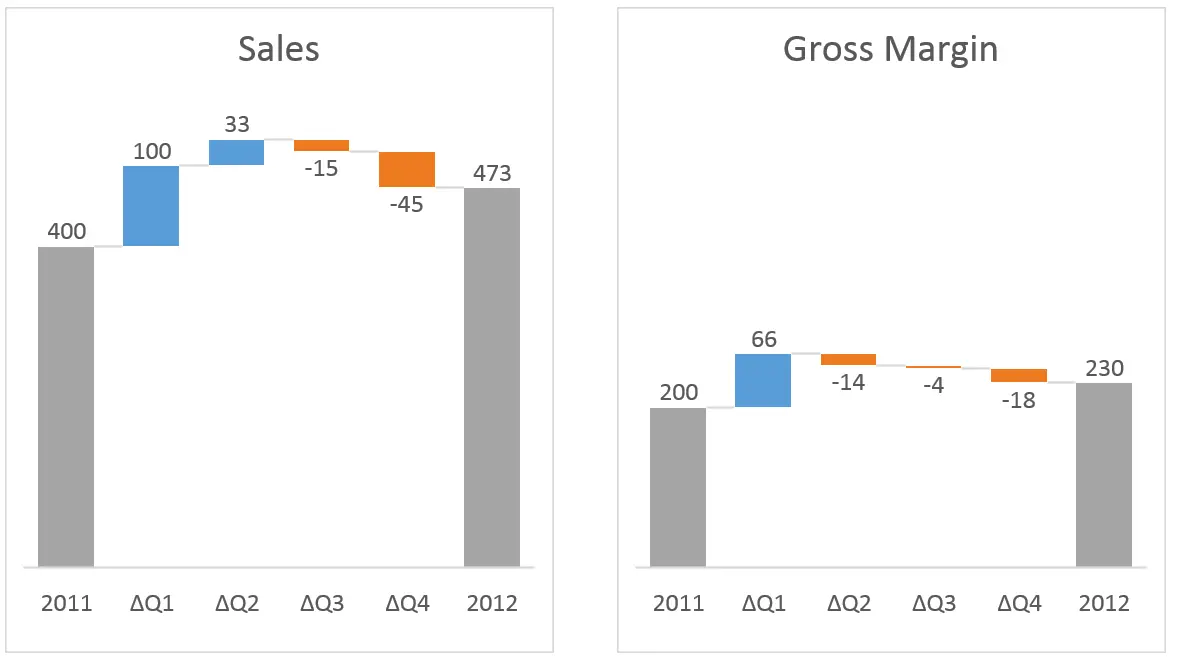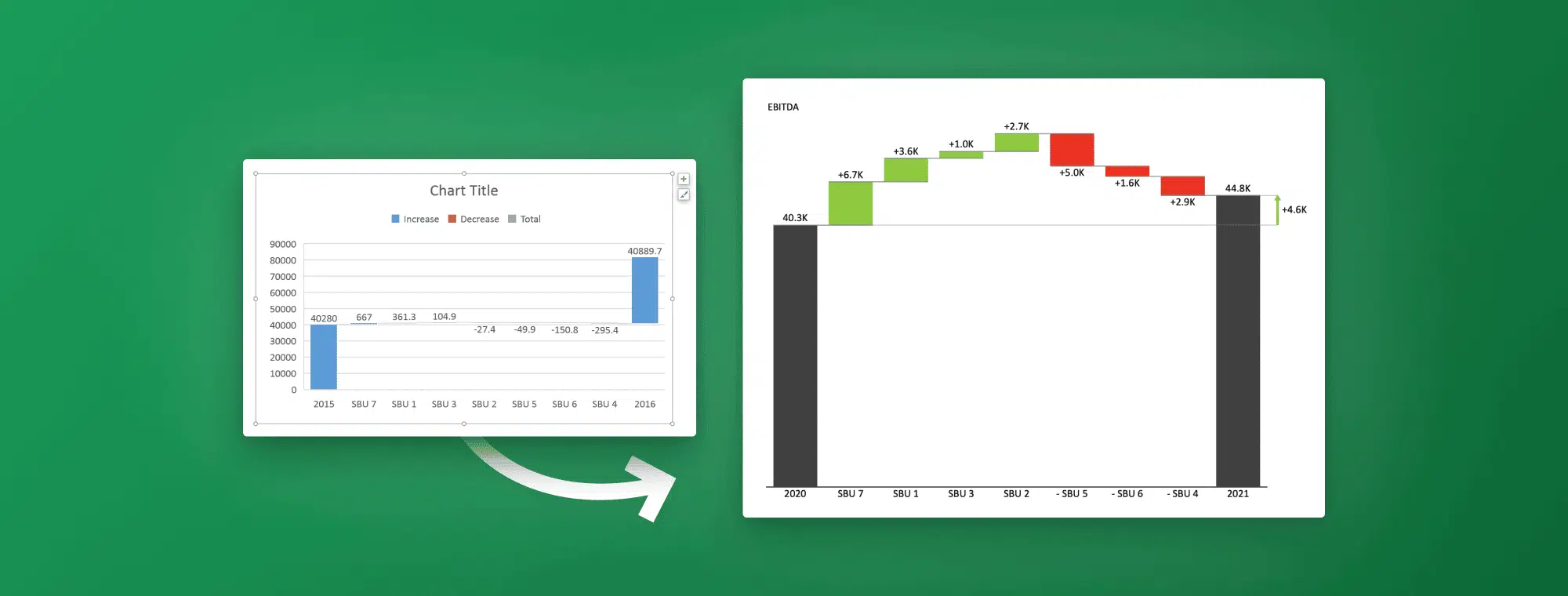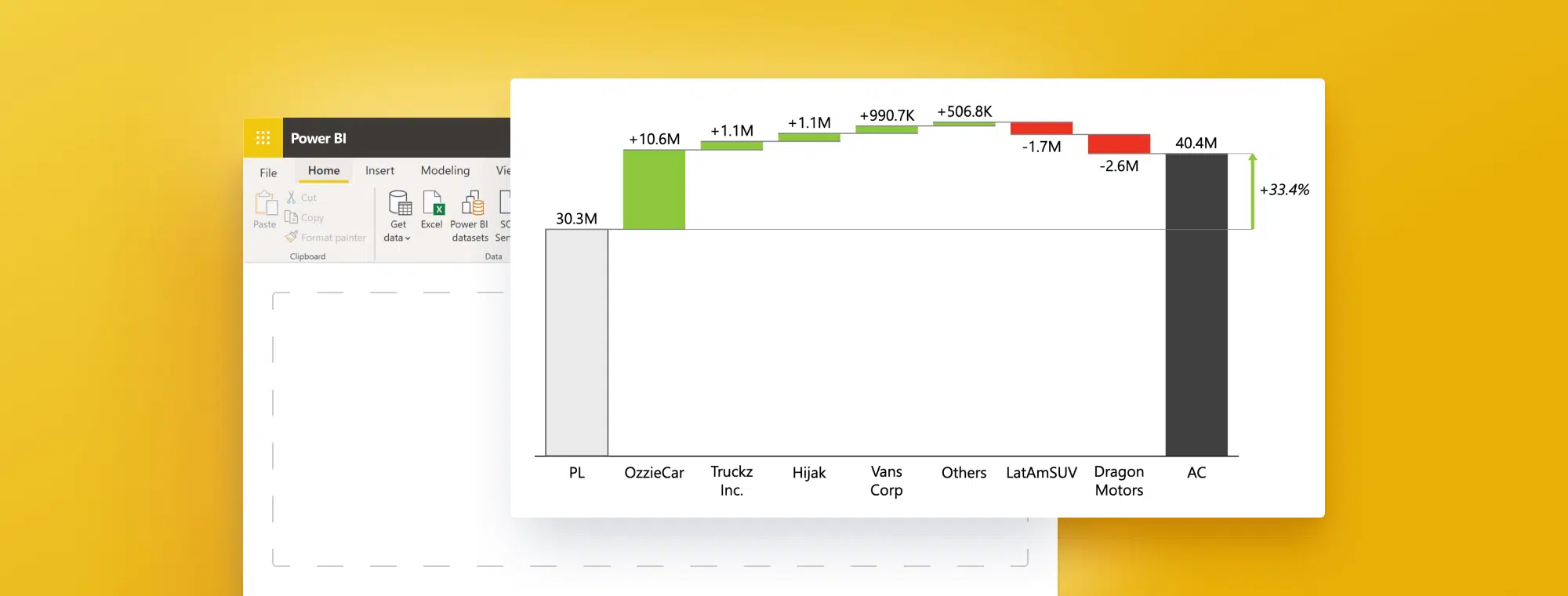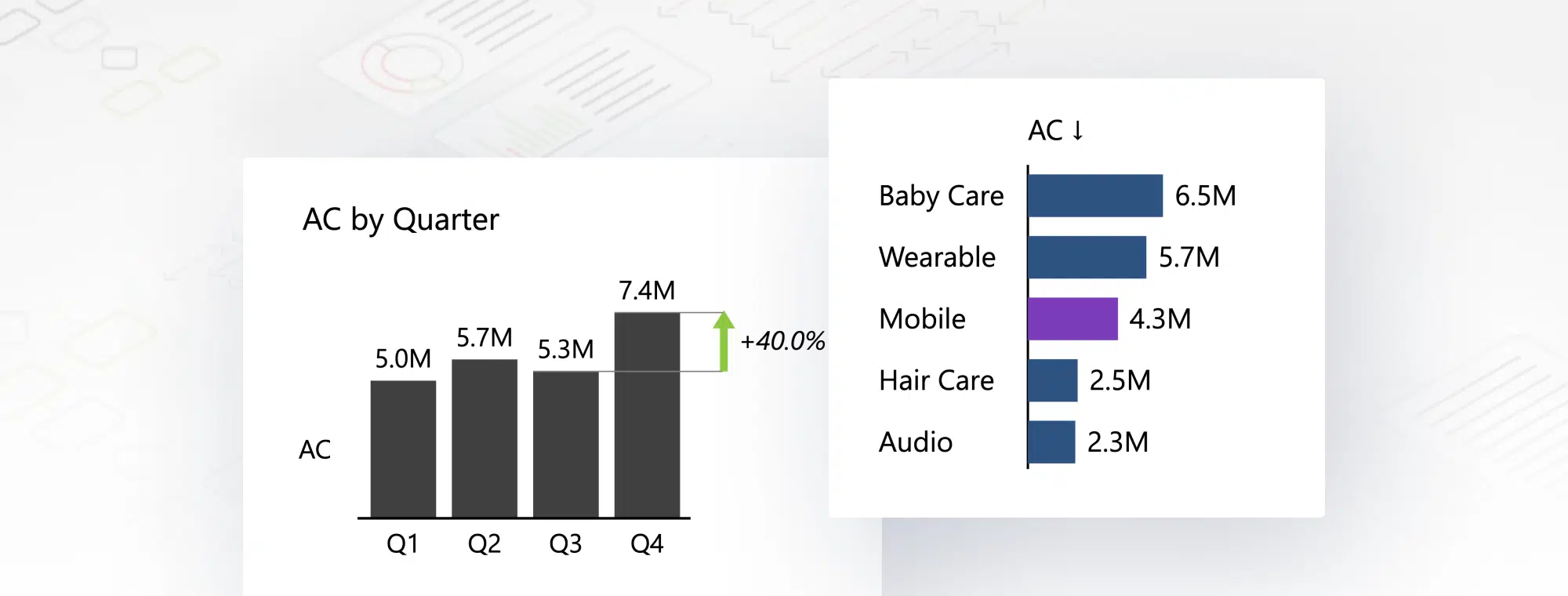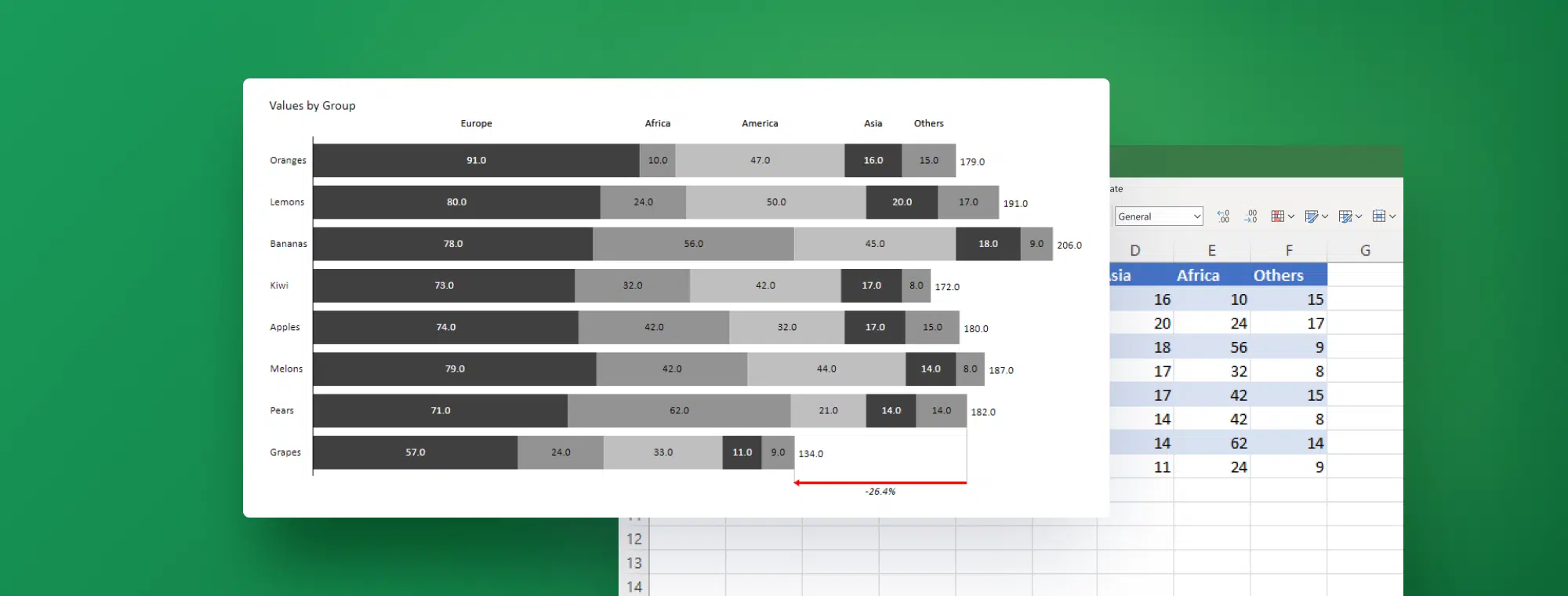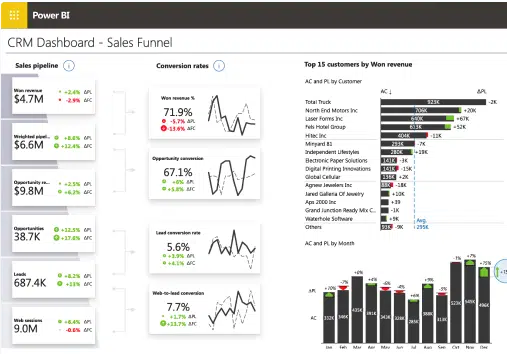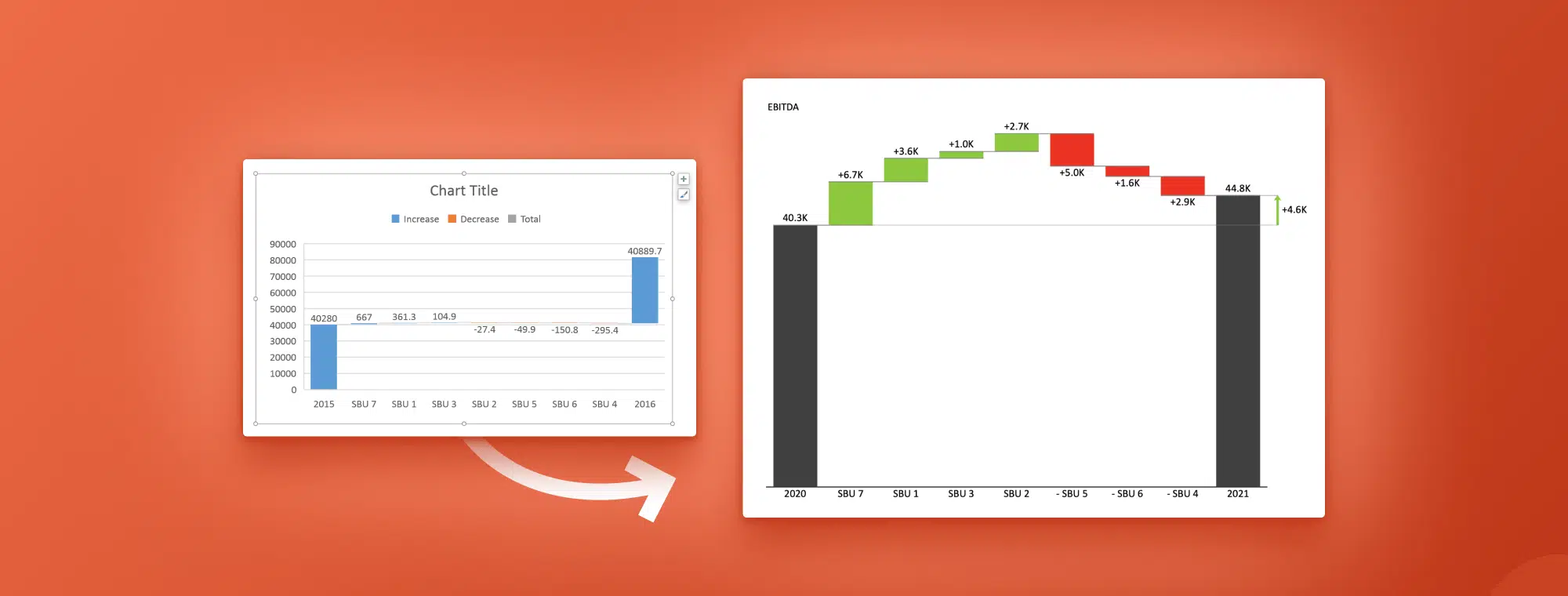
PowerPoint Waterfall Charts: How To Create One That Doesn't Suck
Creating professional-looking PowerPoint waterfall charts may appear intimidating at first, but it is not as challenging as it seems. With the right tools and techniques, anyone can design visually stunning and informative charts that effectively communicate complex data.
Waterfall charts are especially useful for showing how a series of positive and negative values contribute to a final result. This makes them a popular choice for financial and business presentations. In this guide, we'll walk you through the steps for creating polished and engaging waterfall charts in PowerPoint, using simple yet effective design principles and strategies.
Whether you're a seasoned PowerPoint user or a beginner, this guide will provide you with the knowledge and skills you need to create professional-looking waterfall charts that will captivate your audience and enhance your presentations.
Get inspired with our free slide deck!
See how Zebra BI for Office can help you create visually stunning presentations. Try out the 30+ charting options and discover what they can do for you.
Waterfall charts 101
A waterfall chart is a type of data visualization that displays how positive and negative values contribute to a final result. It shows the cumulative effect of values over a series of categories. The chart is called a waterfall because the columns flow from one category to another, resembling a cascading waterfall.
Note: Other fun names for waterfall charts include Mario chart and flying bricks chart, because individual chart elements resemble an old arcade game.
Some people connect the lines between the contributions to make the chart look like a bridge (giving it the name bridge chart — see the example), while others leave them floating.
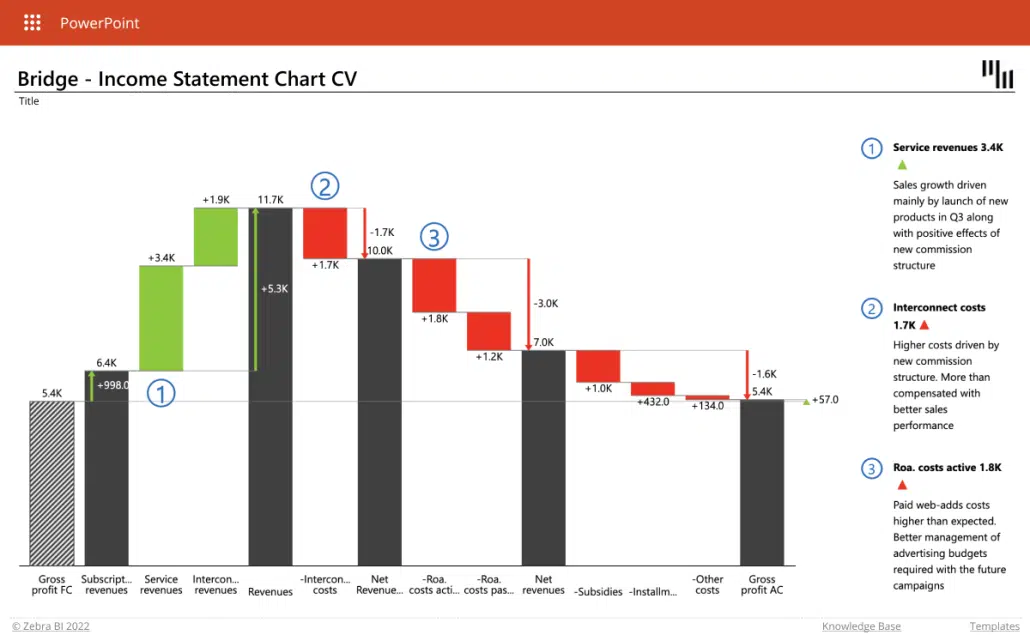
Uses of waterfall charts
Waterfall charts are commonly used in business and finance to illustrate changes in a value over time, such as profit and loss statements, cash flow statements, and budget analyses. They can also be used to compare two different scenarios or to highlight the impact of specific events or factors on a particular value. Additionally, waterfall charts can be used in marketing and sales to demonstrate the contribution of different factors to the overall success or failure of a campaign.
In a nutshell, use a waterfall chart whenever you want to show how a starting value increases or decreases through a series of positive or negative changes.
Tip: While the most typical waterfall chart is the one with a starting and ending value, you can also create subtotals as visual milestones in the series. These show up as full columns.
For example, you might want to use Net revenue and Gross Income as two checkpoints between Gross Revenue and Net income starting and ending values.
How to create a waterfall chart in PowerPoint
Until Office 2016, creating waterfall charts in both Excel and PowerPoint was an arduous process. Things got a bit better with Office 2016, but it still can feel like a daunting task.
Let's start with the process of creating a waterfall chart👇
The easiest way:
This is what your waterfall chart could look like in just a couple of clicks:
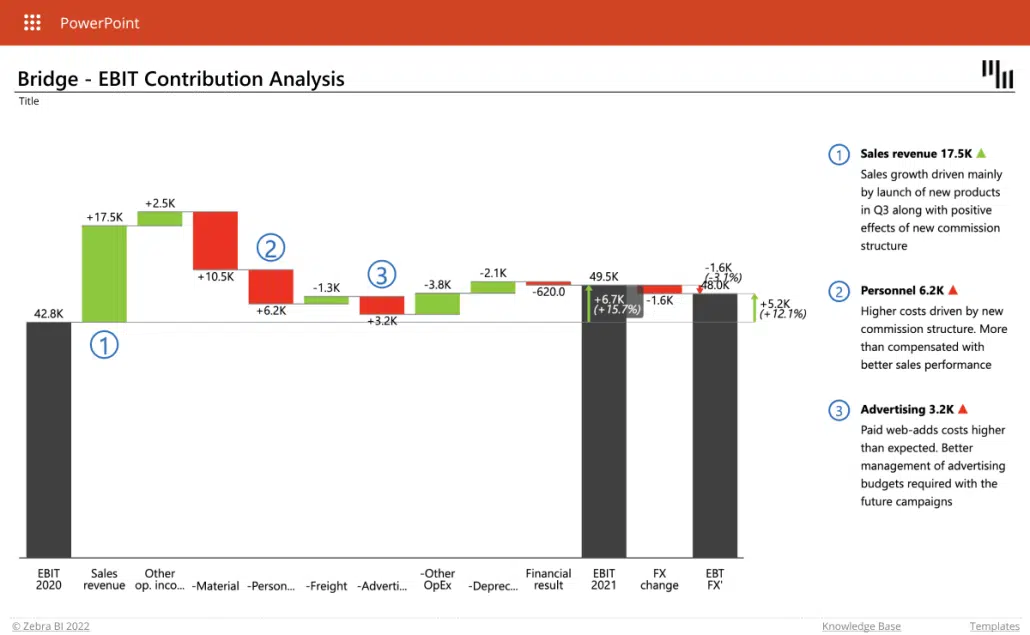
Looks cool and professional, right?
When you don't have time to tweak PowerPoint's waterfall charts, as explained further in the guide, and would like to add those advanced features quickly, Zebra BI for Office is the perfect solution. See just how easy creating a waterfall chart can be:
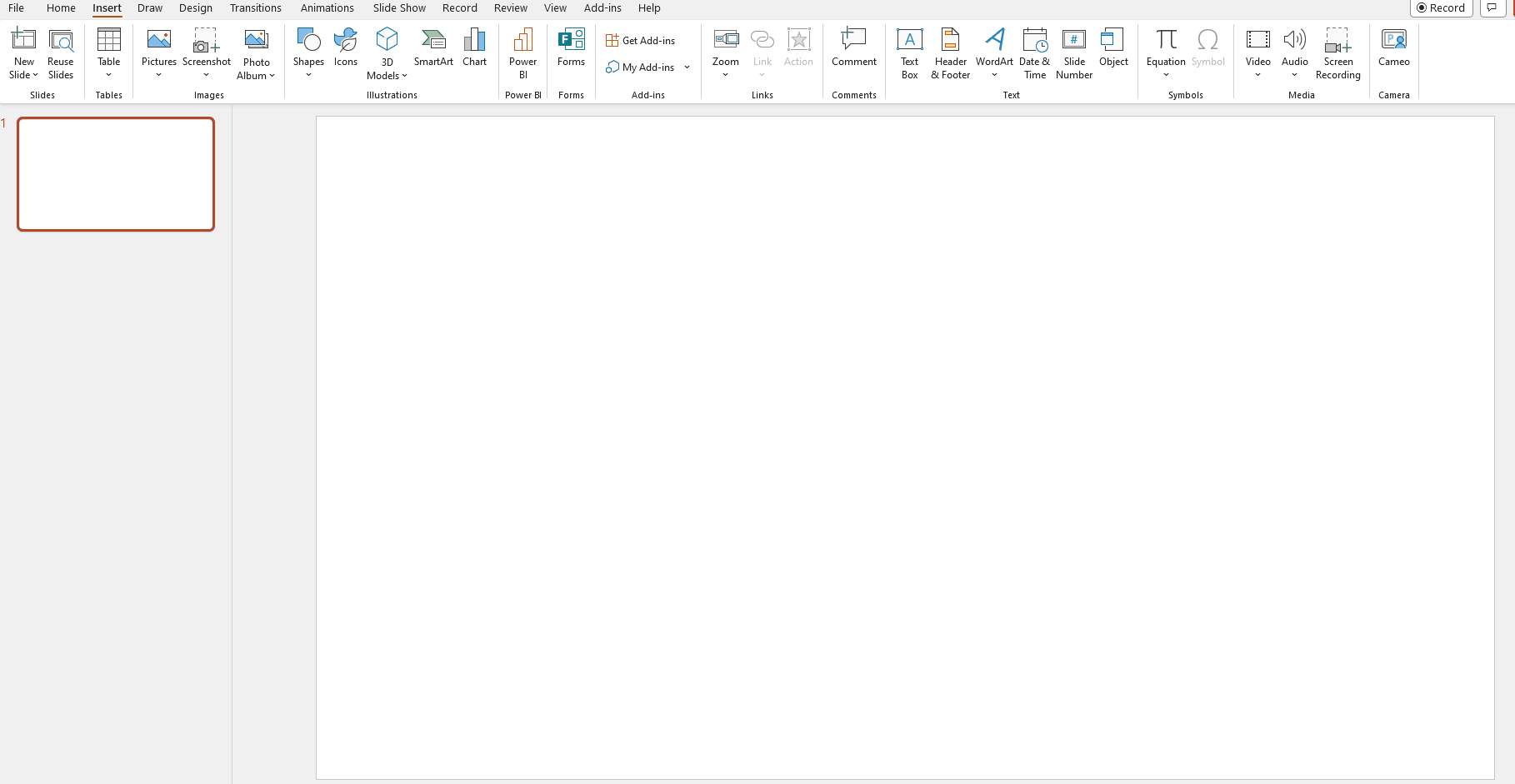
Compared to the other methods explained, this looks like going from a manual transmission car to an automatic one! By the way, you can do this in Office 2019 and 2021, Office 365, and Office for Mac! It's also possible to do the same thing in Excel, too.
And now, let's check how to do it with the native PowerPoint charts👇
PowerPoint way:
Microsoft decided to listen to user feedback and introduced 6 highly requested charts in both Excel and PowerPoint in Office 2016, including a built-in waterfall chart.
No more templates, additional series, formulas, or tinkering with the charts. Just 2 clicks and your awesome waterfall chart is inserted.
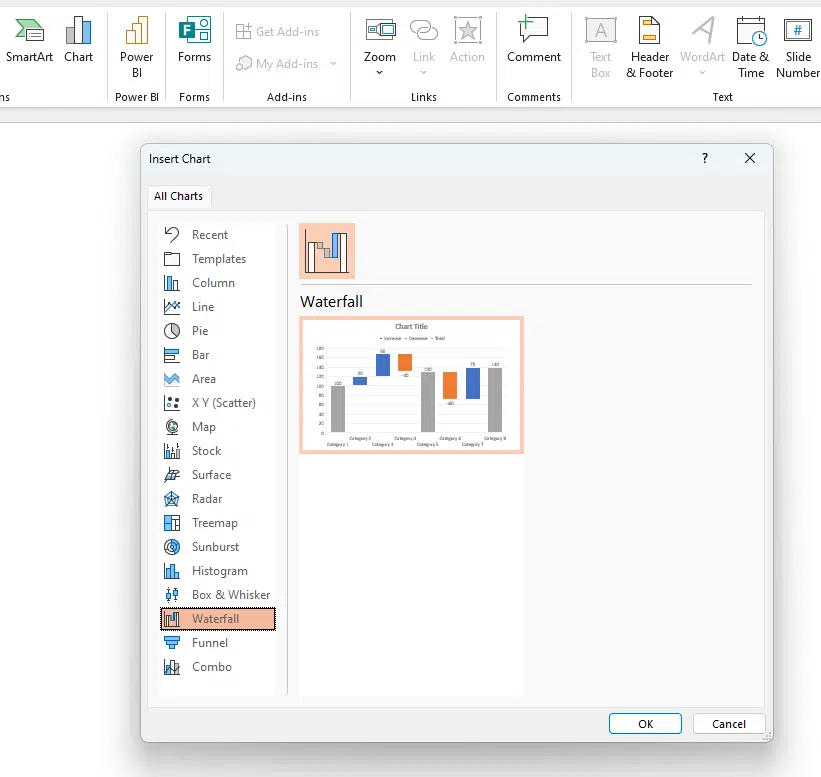
Or is it? 🤨
While the addition of waterfall charts in PowerPoint is a great step forward, the current functionality still leaves much to be desired.
10 steps to a perfect PowerPoint waterfall chart
Here are some ways that can help you create better PowerPoint waterfall charts and some things that are still missing. If you change your mind and want to do it easier, just download our free template and save your time for some better things.
1. Remember to set the totals
The first step is to insert the waterfall chart on your PowerPoint slide.
This shouldn't be too hard. Go to the "Insert" tab and click "Insert Waterfall Chart" and then click on the chart. Voila:
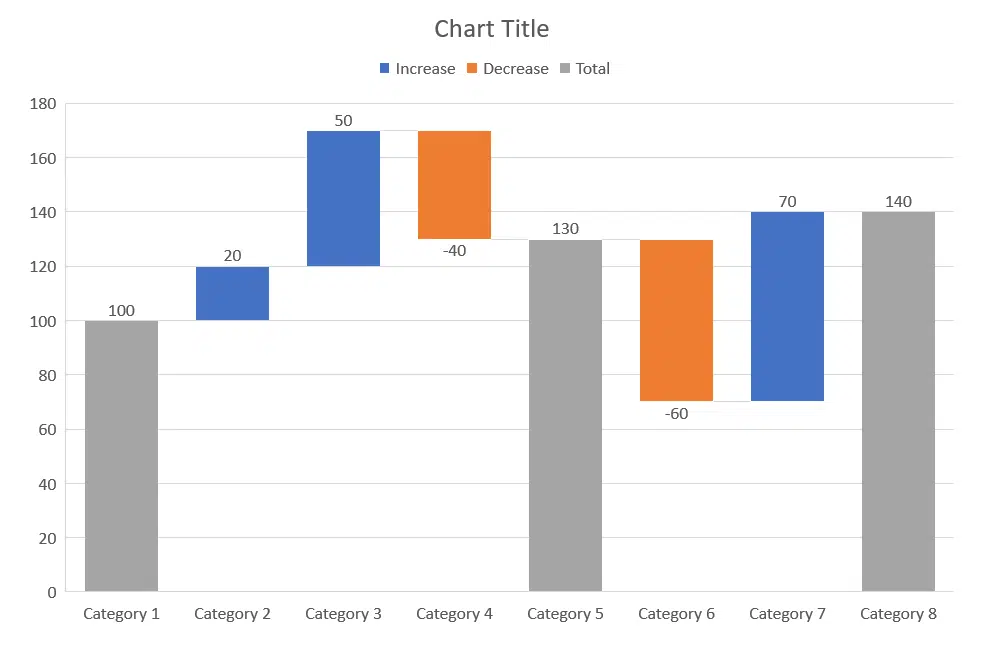
This looks OK. Now, we need to change the dummy data with what we want to be visualized: EBIT contribution analysis.
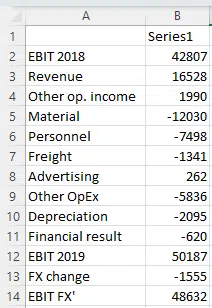
When you just copy and paste it, this is the result you'll get:
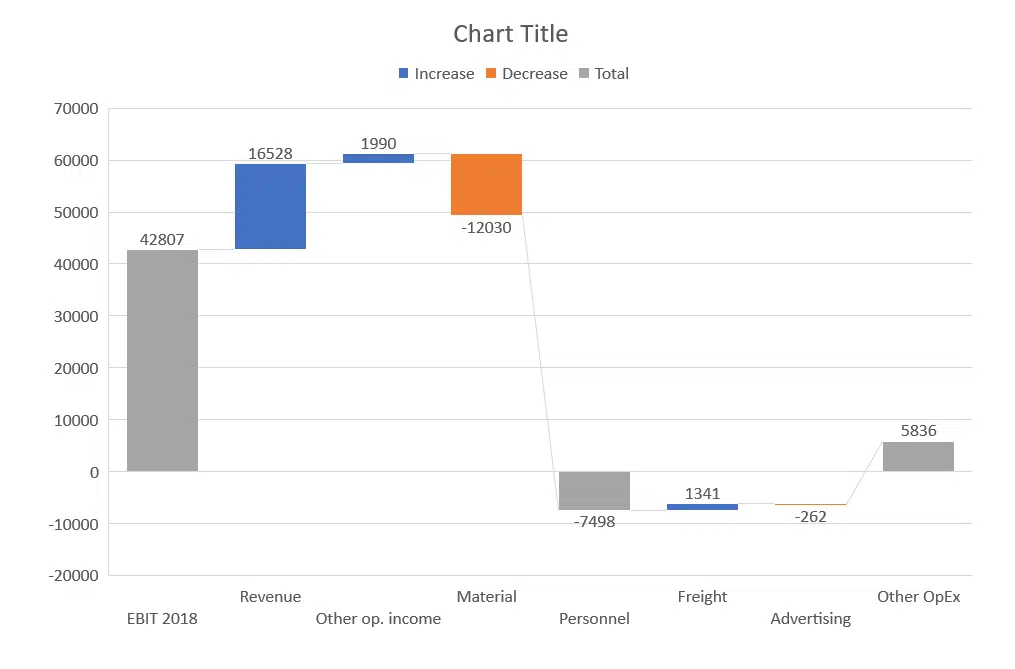
OK, technically this is a waterfall chart, but it's not exactly what we hoped for. And some data is missing, too. Let's fix this first. Double-click anywhere on your waterfall chart and open Select Data.
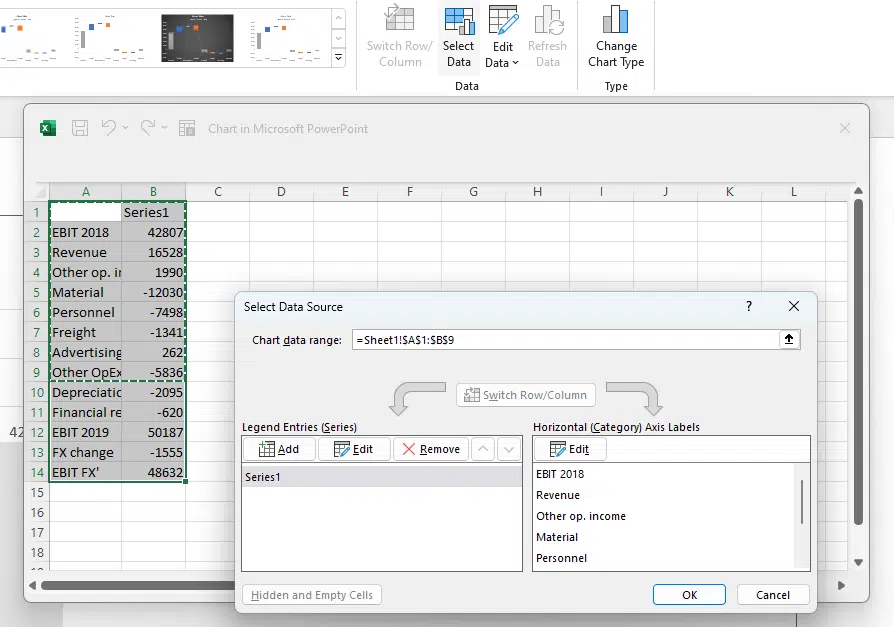
You will see that the Chart data range has not been automatically updated. Just select your new range and click OK.
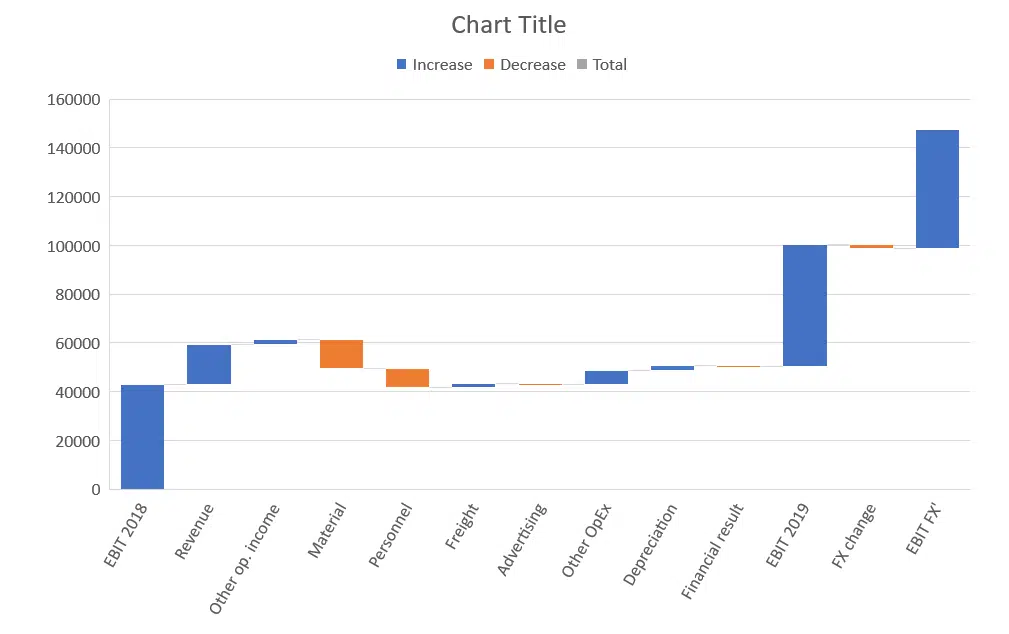
This is still not the waterfall chart we had in mind. In the legend we see PowerPoint has 3 types of columns in a waterfall chart:
- Increase
- Decrease
- Total
This is correct, but in the chart, there are no Total columns, only Increase and Decrease. The EBIT 2018, EBIT 2019, and EBIT FX' should be shown as totals. To set them as such, we have to double-click on each of them to open the Format Data Point task pane and check the Set as total box.
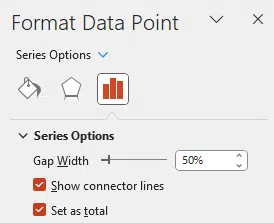
You can also right-click the data point and select Set as Total from the list of menu options.
Or, you can skip all this and use Zebra BI for Office to do the hard work for you.
Finally, we have our waterfall chart:
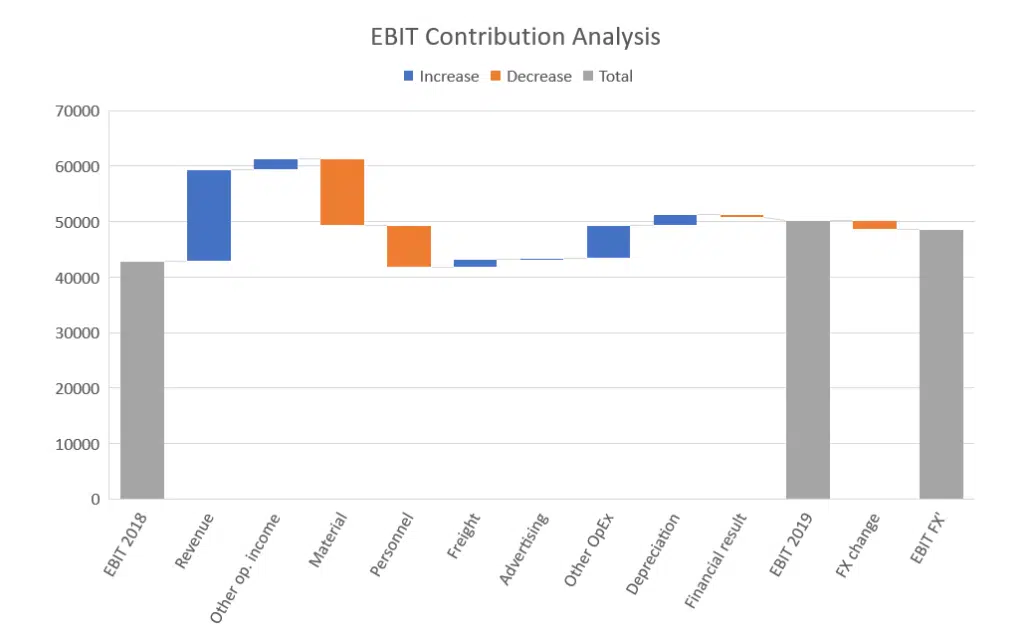
2. Ditch the clutter on your visualization
Data visualization best practice is to remove ALL elements from the visualization that is not absolutely necessary (you can learn more about this in our free webinar: Data visualization in depth).
Similar to other charts, the default PowerPoint waterfall chart also suffers from having too much clutter. The legend, the vertical axis, and labels, the horizontal grid lines - none of them contribute to the reader's better understanding of the data. If anything, they are a distraction.
So, let's remove all unnecessary elements and write our key message to the title. It’s a shame that the chart title cannot be inserted automatically from a cell.
To remove the distracting chart elements, open Chart Elements (+) and uncheck unnecessary elements. Or, right-click on each of them and then click "Delete".
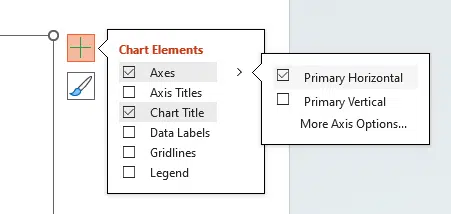
Great, this is much better. But it required additional work that would not be required if PowerPoint defaults were better. We’ll show you how to do it better in Zebra BI for Office.
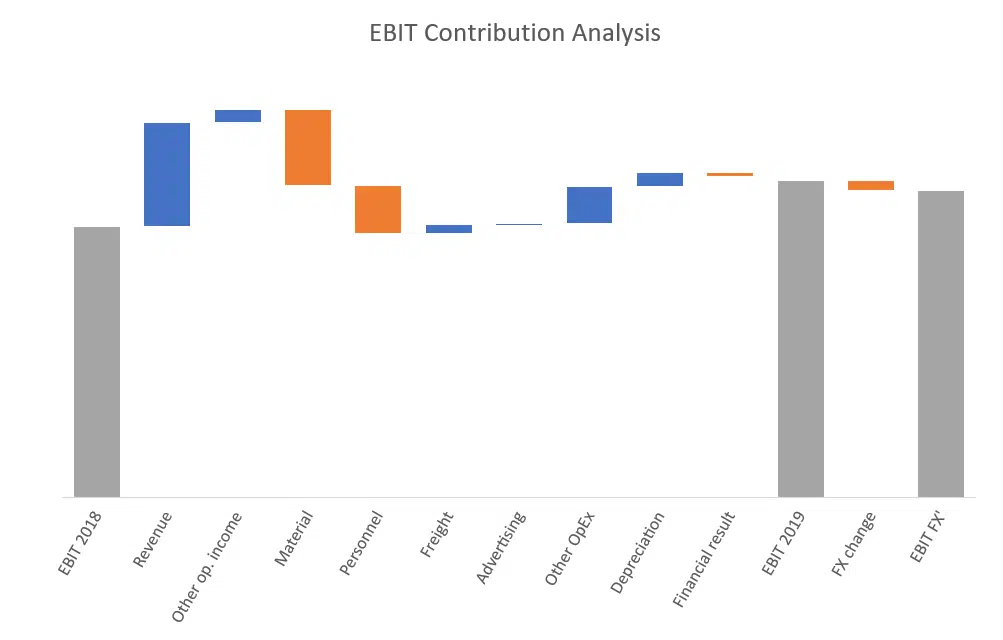
3. Break the axis to highlight contributions
This limitation is especially noticeable in waterfall charts because waterfall charts have essentially two different types of data:
- Totals: usually the first and last column in a series.
- Contributions: the floating bricks make up the “bridge” between the two totals.
A common problem is that contributions are often very small compared to totals. This is also apparent in our example (see the image above).
First, a point of order: this chart correctly visualizes the situation as the contributions really ARE that small compared to totals: Advertising compared to EBIT 2018, for example.
This visualization is also completely in line with IBCS Standards.
However, users (and their bosses) are sometimes more interested in contributions than in totals and the relationship between the two.
In this case, the only viable option would be to break the vertical axis and have the totals start at some value larger than 0. Let’s say 20,000. This highlights individual contributions, but risks guiding unaware readers to false conclusions about the data.
Another, somewhat simpler option how to break the axis in a PowerPoint chart is to do the following:
- Click on the chart to select it
- Re-add vertical axis: Go to Design >> Add Chart Element >> Axes >> Primary Vertical
- "Break" vertical axis: right click on the vertical axis and click "Format Axis...", then under Axis Options write "20000" under Bounds >> Minimum.
- Remove the vertical axis again: right click on the vertical axis and click "Delete"
This is the chart we end up with:
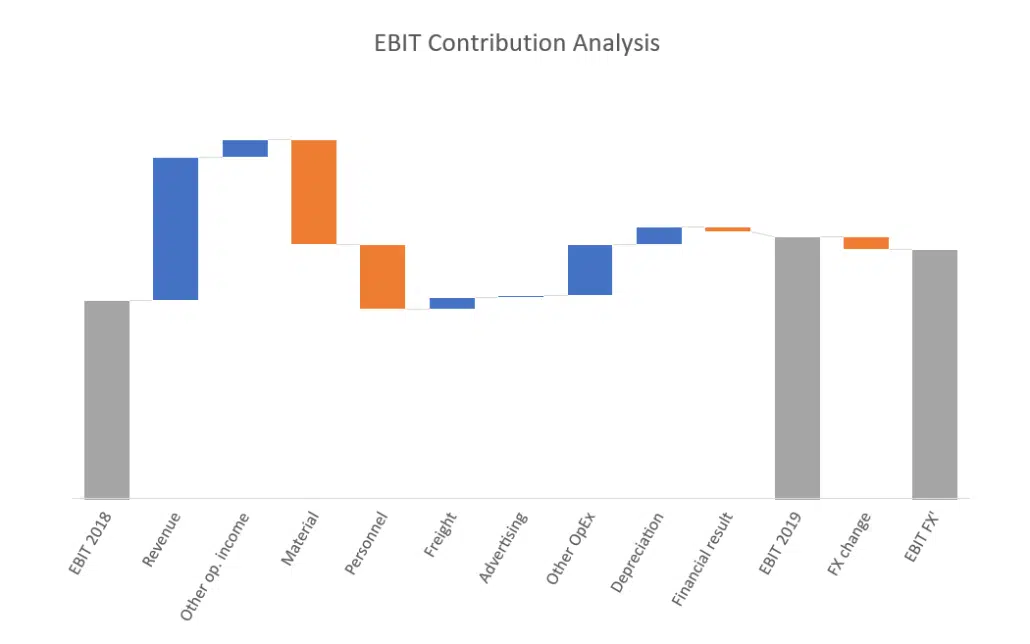
Now the contributions are much more prominent, but there's no obvious indication that the vertical axis does not start at zero which is really bad because the user does not draw the correct conclusion from the visualization.
4. Add relative contributions in percentages
When analyzing contributions you're sometimes more interested in relative contributions (in percentages of the total) than in absolute contributions.
Unfortunately, if you want to do that in a default PowerPoint waterfall chart, you're out of luck - you're stuck with displaying absolute contributions only.
✔️ Look to the end of the article to see how easy this is to do in Zebra BI for Office.
5. Highlight differences between totals
Another thing that you're not able to do in a PowerPoint waterfall chart is to display the total difference between EBIT 2018 and EBIT 2019 in our example.
Sure, you can see in the chart that the EBIT 2019 column is higher than the EBIT 2018 column (especially now that we cut the vertical axis). But by how much? Unless you can do complex subtractions in your head, you don't know the exact number. There’s also no way to display the relative difference in percentage.
Since this difference between totals is rather important, it's definitely a major feature that's missing in PowerPoint waterfall charts.
✔️ Of course, it's much easier to highlight the differences in Zebra BI for Office.
6. Use vertical waterfall charts
We know from the How to Choose the Right Business Chart article that horizontal charts (i.e. the charts that have a horizontal category axis) are used to display time-related data. For everything else, we should use vertical charts instead.
Waterfall charts are no exception. Strangely, in PowerPoint, there is no way to insert a vertical waterfall chart. While this feature has been requested, there's no indication of whether it will be implemented and when.
✔️ We prepared a demonstration in Zebra BI for Office, so you can see how to create an income statement with vertical waterfall charts.
7. Add (some) subtotals
Since we're on the subject of visualizing income statements - in a typical income statement, there are some categories that are actually sums of several other categories.
For example, you can choose to calculate a sum of all Operating Expenses (OpEx). This better visualizes the relationship between "Revenue" and "Earnings before interest and taxes" (EBIT). EBIT = Revenue - OpEx.
This is easy to do in a table - write a formula and you're done.
When you create a waterfall chart in PowerPoint? Not so much. It's apparently so hard to do it manually that there's not a single tutorial or template available on the internet.
You can, however, enter subtotals and designate them as such in your waterfall chart. However, you need to calculate them yourself to make sure they are correct.
✔️ You can see how Zebra BI for Office automatically creates subtotals in this handy animated gif at the end of this article.
8. Customize your chart with colors
The default color scheme in PowerPoint could be better. Visit the Chart Design tab and open the Change Colors gallery.
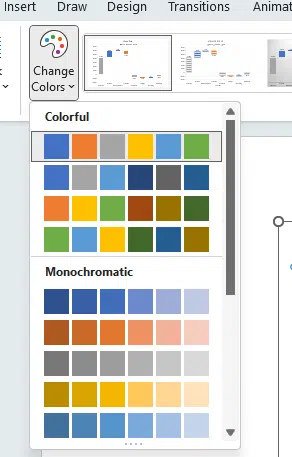
Here, you can select a color palette.
You can set it up to display positive values in green and negative values in red, which is a common approach in financial reporting.
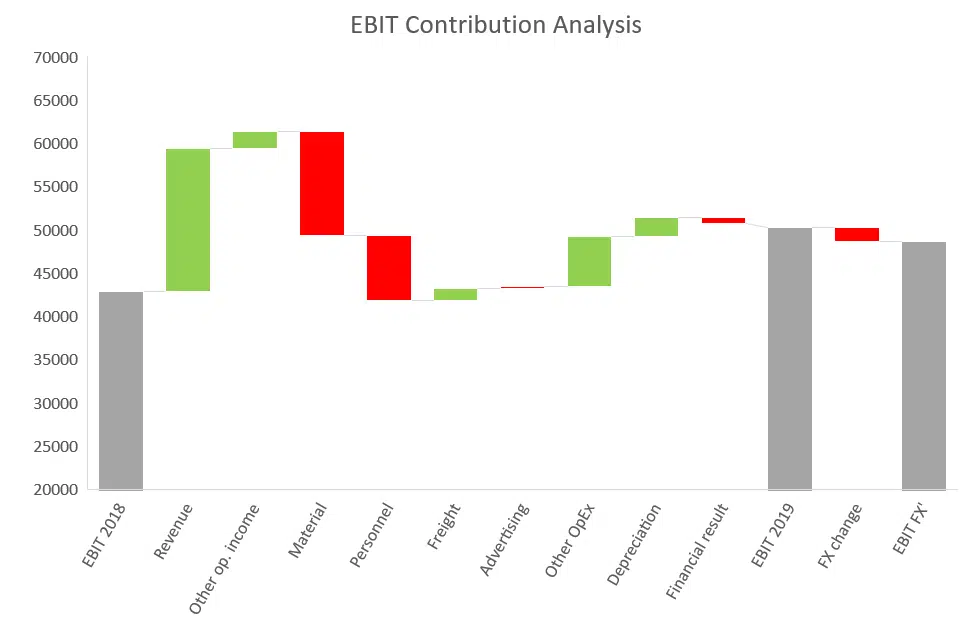
9. Turn connector lines on or off
Connector lines connect columns to show the movements in values in the chart. You can turn them on or off by right-clicking a data series to open the Format Data Series pane and checking/unchecking the Show connector lines box.
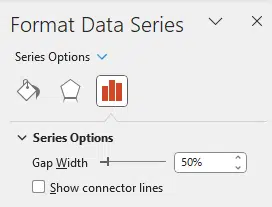
10. Scale your charts
Finally, we arrive at one major feature that's missing in PowerPoint from the very beginning: scaling multiple charts.
While this problem is not limited to waterfall charts, it's too important not to mention it here.
Making sure that all related charts in a report or dashboard are on the same scale is one of the most important concepts in data visualization.
Note: If you don't synchronize scales, don't even insert the charts
All too often you see two PowerPoint charts side by side with completely different scales. While each of them is an adequate data visualization on its own, you must make sure they are scaled once you put them side by side! Otherwise don't even insert the charts and just leave the data in a table — or risk misleading/incorrect interpretation.
So, how do you synchronize scales of PowerPoint charts? While the procedure is not particularly hard, it is time-consuming. It's a similar procedure that we used to break the axis.
Say we have these two default PowerPoint waterfall charts and we need to scale them:
The first step is to re-add Vertical Axis on both charts.
- Click on the first chart to select it
- Re-add vertical axis: Go to Design >> Add Chart Element >> Axes >> Primary Vertical
- Repeat for the second chart
This is what we have so far:
Now we have to adjust the scale of the right chart to be the same as the left. Right-click on the vertical axis and click "Format Axis...", then under Axis Options write "600" under Bounds >> Minimum.
Remove the vertical axis from both charts (right-click on the vertical axis and click "Delete") and we have our correct visualization:
OK, that wasn't too bad. Now, what if you have a monthly report with 6 waterfall charts on it? Would you do this procedure for 6 charts every month when the data changes? I guess not.
Of course, you can automate this, but you have to use VBA to do it.
Some more advanced things you can do much easier
You got it so far: everything is much easier if you use Zebra BI for Office instead of native PowerPoint charts. See what else can be done 👇
Adding variances and difference highlights
The default PowerPoint waterfall charts do not show a very important feature that is crucial for the understanding of your performance: variances (absolute & relative) and difference highlights. In Zebra BI for Office, both features are applied automatically.
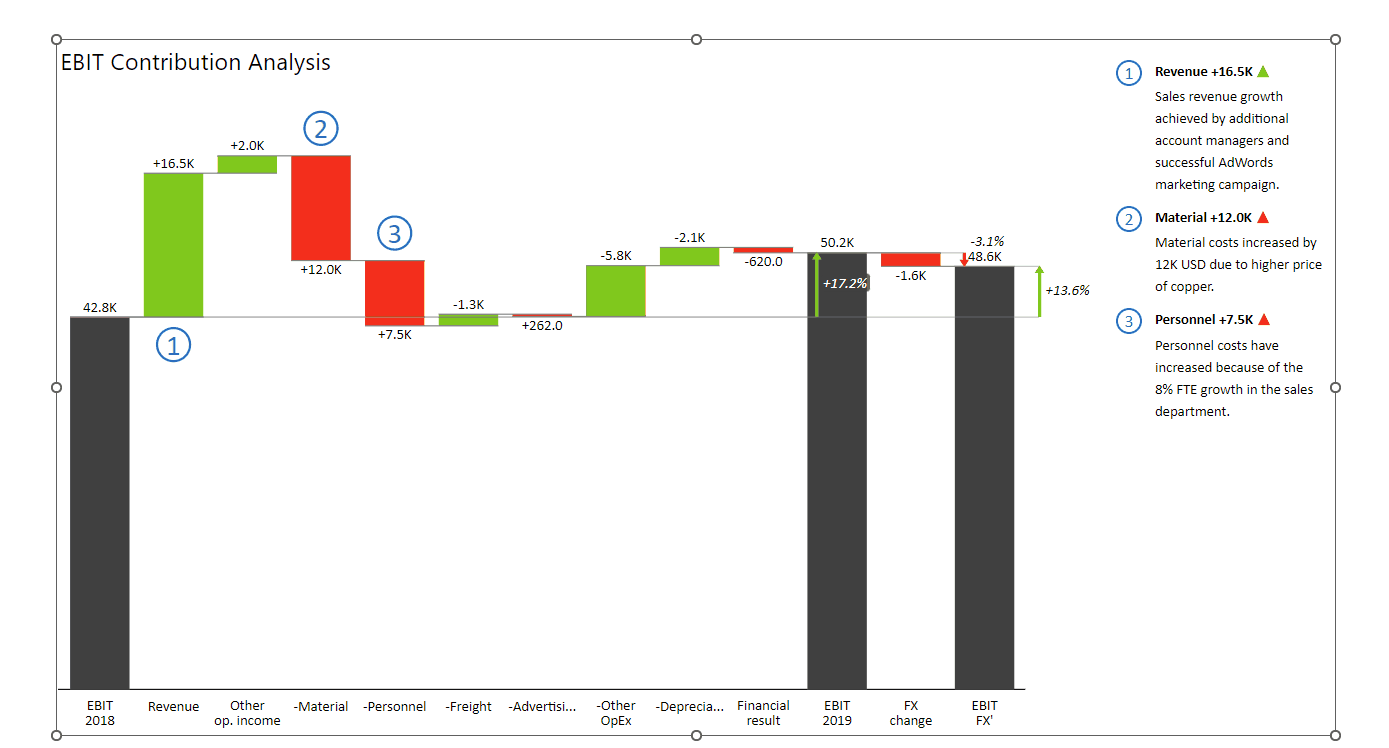
You can also control whether an increase is a positive or a negative event. We know that in some cases, like when it comes to costs, an increase is a negative development. You can simply click on the category where data should be inverted and select a custom calculation "Invert". This will automatically adapt the visualization to display the right context.
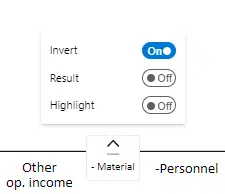
Another useful feature we added is the difference highlights between starting and ending values. The difference highlight is added automatically and is on by default. By going to the settings in the global toolbar, you can also switch it off.
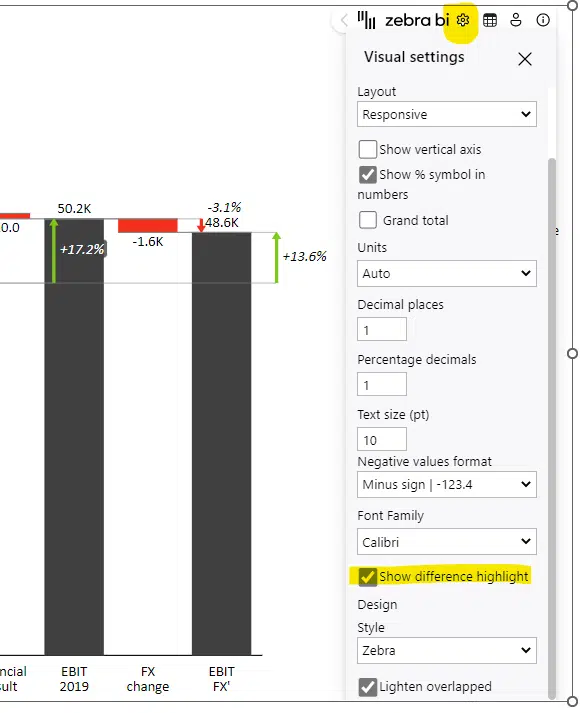
In the previous example, you can see that the increase between EBITDA in 2020 and 2021 was 4.6k or 11.3%.
Creating an income statement with vertical waterfall charts
How about inserting a waterfall chart into an income statement? With the Zebra BI Tables for Office add-in, this is just a few clicks away.
The cool thing about this is that by glancing at the waterfall chart, you can already see how you're performing. The calculations like "Result" and "Invert" are reflected in the waterfall chart and all categories get subtracted so that you can clearly see the contribution of each to the final result.
Now it's your turn
Download the inspirational slide deck, impress everyone at your next meeting, and change your presentations forever!

 September 8th
September 8th February 22nd
February 22nd
